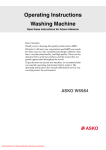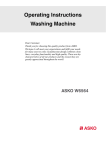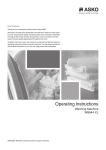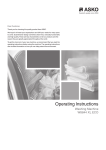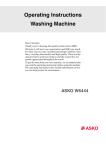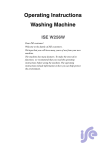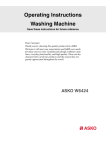Download Asko W6984 Operating instructions
Transcript
Operating Instructions Washing Machine Dear Customer, Thank you for choosing this quality product from ASKO. We hope it will meet your expectations and fulfil your needs for many years to come. Scandinavian design combines clean lines, everyday functionality and high quality. These are key characteristics of all our products and the reason they are greatly appreciated throughout the world. To get the most from your new machine, we recommend that you read the operating instructions before using the machine. The operating instructions also include information on how you can help protect the environment. ASKO W6984 Contents Before using your machine for the first time Transport protection Packing material Washer door Language selection Time display options Set the clock Checking water hardness Safety instructions General Installation Overflow guard function Transport/Winter storage Recycling Child safety Keep an eye on children! Child-safe Description of the washing machine Detergent compartment Advice and tips before washing Sorting your laundry Clothing Laundry labels Laundry label symbols Coloured cotton Unbleached linen Wool Rayon fibres and synthetic fibres Stain removal Reducing allergic reactions Save time and energy High water level Economy and efficiency Detergents Dyeing fabrics 2 4 4 4 4 4 4 4 4 5 5 5 5 5 5 6 6 6 7 7 8 8 8 8 8 8 8 9 9 9 9 9 9 9 9 10 Washing Sort your laundry. Turn on the main power switch Open the washer door and load the washing Add detergent and fabric softener, as required Select the program Select options Close the washer door and press the Start/Stop button Once the program has finished Settings You can change the following settings: Child-safe Door opening Temperature Extra rinses Pre-soak Anti-crease function Clock Audible Volume Spin option Select language Return Care and cleaning Cleaning the trap and the drainage pump Cleaning the detergent compartment Cleaning the outside of the machine Cleaning the inside of the machine to avoid unpleasant smells Rinse holes under the agitator If you have hard water 11 11 11 11 11 12 15 17 17 18 18 18 18 19 19 19 19 19 20 20 20 20 21 21 21 21 21 22 22 Contents Troubleshooting The washer door will not open The machine will not start Error messages Technical information Technical data Information for test institute Transport protection Installation Positioning the washing machine Adjusting the feet Connection to water supply Drainage connection Electrical installation Door hanging Follow these instructions: Fitting the wooden door Service Before contacting the service division Quick guide 23 23 23 24 25 25 25 27 29 29 29 29 30 30 31 32 33 34 34 36 3 Before using your machine for the first time Transport protection Remove any transport protection devices before installing the machine. See the "Transport protection" chapter. Packing material Sort waste materials in accordance with local guidelines. Washer door • The washer door will not open until the machine is connected to the electricity supply. • To open the door manually, see "The washer door will not open" in the "Troubleshooting" chapter. • The machine cannot be started when the door is open. • To open the washer door while a program is running, see "Close the door and press the Start/Stop button" in the "Washing" chapter. Language selection You will be prompted to select the display language when you have connected your machine and start it for the first time. Do as follows: Turn the program selector to choose from: US English, English, Svenska, Dansk, Norsk, Suomi, Français, Deutsch, Italiano, Espanol, Русский, Nederlands. Press the button in the middle of the program selector or Start/Stop to save and to move on to the clock and time display settings. Time display options The time is shown on the display. Press the up or down arrow button to choose 12h, 24h, or display remaining time. Press the program selector or Start/Stop to confirm. Once you have made a selection, the menu for setting the clock will open. Set the clock 1. Press the up or down arrow button until the correct hour figure is displayed. Press the program selector to confirm. See Quick guide on the last page 4 2. Press the up or down arrow button until the correct minute figure is displayed. Press the program selector or Start/Stop to save. Once you have made a selection, the program menu will open. Checking water hardness The quantity of detergent needed depends, amongst other things, on how hard the water is. See the detergent pack for details. Phone your local water company to check the water hardness in your area. NOTE! Each machine is tested before leaving the factory. A small amount of water may remain in the drain pump, though this does not affect quality or damage the machine. Safety instructions General Transport/Winter storage • Read the operating instructions and keep them in a safe place. • Installation should be carried out by qualified ASKO technicians. • The machine should only be used for washing items as described in these instructions. It is not intended for dry cleaning. • Use only detergent intended for machine washing! • Remove any transport protection devices before using the machine. See the "Transport protection" chapter. • Repairs and maintenance must be carried out by a qualified professional. • Damaged mains cables must only be replaced by a qualified electrician. • The machine is not designed to be used by persons (even children) that are physically or mentally handicapped or lack experience and knowledge. Such persons must receive instruction in how to use the machine or be supervised by a person responsible for their safety. • Children must be watched to ensure they do not play with the machine. • In the enclosed plastic bag you will find a tool for opening the washer door in emergencies. If the machine is to be transported or stored in unheated premises where the temperature can fall below freezing, do as follows: • Empty the filter and the drainage pump. See the "Care and cleaning" chapter. • Shut off the water to the washing machine, loosen the supply hose to the intake valve and let the water run out from the valve and hose. • After emptying the pump, a small amount of water may remain in the machine. This does not affect quality or damage the machine. Recycling This machine is manufactured and labelled for recycling. In order to prevent injuries, the machine must be made unusable once the decision has been taken to dispose of it. Contact your local authority for information about where and how your machine can be recycled correctly. Installation See the "Installation" chapter. Overflow guard function If the machine’s water level rises above the normal level, the overflow guard function begins to pump water out and shuts off the water intake. If the water level has not dropped within 60 seconds, the program is terminated. 5 Child safety Keep an eye on children! Child-safe • Always close the door and start the programme immediately once you have added detergent. • The appliance is not intended for use by young children or infirm persons without supervision. • Young children should be supervised to ensure that they do not play with the appliance. • Store detergent and fabric softener out of the reach of children! • In order to prevent children from starting a program or changing one that has already started, you can activate a Child-safe start You can activate the Child-safe start option to prevent children from starting the machine. You can deactivate the Child-safe start option by pressing the Start/Stop button and the program selector (the big arrow) at the same time. The Child-safe start option will be temporarily deactivated for three minutes. 1. Press the up or down arrow buttons until Child-safe Start appears in the middle of the display. 2. Press the program selector again (the big arrow) to access the options menu on the right of the display. 3. Press the up or down arrow buttons to select Off or On. 4. Press the program selector to save your setting. 5. If you do not want to select any more settings, press the arrow button down until you reach the program you want. CAUTION! If this appliance is supplied from a cord extensions set or electrical portable outlet device, the cord extension ser or electrical portable outlet device must be positioned so that it is not subject to splashing or ingress of moisture. 6 Description of the washing machine 1. 2. 3. 4. 5. 6. Main power switch Detergent compartment Program panel Serial number plate (on inside of washer door) Drainage pump cover Drainage pump (behind cover) 1 2 4 3 5,6 Detergent compartment 1. 2. 3. 4. Pre-wash Main wash Main wash liquid detergent. Fabric softener 1 2 4 3 7 Advice and tips before washing Here are some tips that may help you before washing. Sorting your laundry Sort items according to: • how soiled they are • colour • material Clothing 1. Do up zips and close Velcro straps so that they don’t harm fabrics. 2. New coloured items may contain excess dye and should therefore be washed separately the first few times. 3. Turn delicate items inside out. This reduces the risk of burling and fading. 4. Empty pockets and wash them inside out if possible. Laundry labels Look at the item's laundry label. The table below shows suitable wash programs for different materials and wash loads. Using modern washing machines and detergents, for example compact detergents, you can usually wash at lower temperatures. It is a good idea to use trial and error to find out what produces the best results. Laundry label symbols Examples of washing instructions and recommended programs. Always follow the washing instructions for each garment. Laundry labels 8 Material Program Load Cotton, linen, white and light-coloured items. Colour/White 60 °C to 95 °C 1/1 drum Cotton, linen, cotton/polyester. Light and dark-coloured garments. 1/1 drum Quick 60 °C Polyester, polyamide, elastane, acrylic. Light Synthetics 40 °C and dark-coloured garments. 1/1 drum Acrylic, viscose, modal, acetate. Easy Care 40 °C 1/2 drum Silk and very delicate items Synthetics 30 °C 1/3 drum Wool and other very delicate garments Wool/Hand 30 °C to 40 °C 1/3 drum Coloured cotton Unbleached linen Coloured cotton items with the washing instruction 60 °C should be washed at 60 °C for the first time in order to remove any excess dye. If you do not do so, there is a risk that the colour will run. Use detergent without bleach in order to preserve the colour of the fabric. Unbleached linen fabrics should be washed at 60 °C, using detergent containing no bleach or optical whiteners. Heavily-soiled linen can occasionally be washed at higher temperatures, but not too often because the heat can destroy the linen’s shine and strength. Advice and tips before washing Wool Save time and energy These fabrics are labelled either machine wash or hand wash. The Wool program is at least as gentle as washing by hand. Use the Colour/White program to save time and energy. This program has a shorter main wash than Normal, but is often sufficient for lightly soiled washing. Wool is especially sensitive to processes such as washing. If you do not wish to spin dry, you can squeeze out the water using terry towels. In this case select No spin. To find out how to choose this setting, see the "Washing" chapter. However, most garments can withstand a short spin. Choose a short spin by selecting a spin speed of 800 rpm or less. Rayon fibres and synthetic fibres Materials made of rayon fibres, such as viscose, and some synthetic fibres are very delicate and require much space so as not to crease. Only half fill the drum when washing and choose a spin speed of 800 rpm or lower. NOTE! Viscose and acetates are fragile when wet. Stain removal The automatic stain program can be used for the following types of stains: Chocolate, Blood, Red wine, Egg, Grass, Diary products, Tea/Coffee, Fat stains grease/oil and Blueberry. The program is suitable for cotton, cotton/synthetics and synthetics. NOTE! For stain removal it is always important to treat the stain as soon as possible. Leaving a stain and allowing it to dry makes it more difficult to remove. It is also important to carefully scrape off any of the stain lying on the surface. Do not load the machine with more than 2,5 kg of laundry. High water level If you want more water for the main wash and rinses, you can use the High water level option. This is automatically selected in the Wool/Hand program. Economy and efficiency You can save energy by not using higher temperature programs than necessary. • Select Quick if you just need to freshen up shirts or exercise clothes, for example. This will save both water and energy. • If you select a fast spin speed, this reduces energy consumption when drying in a tumble dryer or drying cabinet. • Always wash with a full load when using the Heavy, Colour/White and Normal programs. • Avoid pre-washing. Modern machines and detergents clean effectively without pre-washing. Pre-washing is only necessary for heavily soiled washing. Detergents Eco-labelled detergents are less harmful to the environment. Detergent overdosing does not give better washing results; it merely causes a greater impact on the environment; can also hinder the wash performance. Try to use less detergent, and increase only if you are not satisfied with the results. Reducing allergic reactions The washing machine has a Super Rinse option. Use this for people with sensitive skin, such as those with allergies and small children. 9 Advice and tips before washing Dyeing fabrics If you want to dye fabrics in the machine, select the Colour/White program with the Super Rinse option. Select temperature according to the dye manufacturer’s recommendations. Choose a low spin speed if the fabric to be dyed is a blended material such as polyester/cotton. NOTE! Add the dye directly to the washing drum – not to the detergent compartment. After dyeing, you should run the machine empty using the same program. Use the normal amount of detergent. NOTE! Due to environmental concerns, we discourage the use of strong chemicals. When using agents for bleaching or stain removal, there is a risk of rust (corrosion) and discolouration of the machine. 10 Washing 1 Sort your laundry. NOTE! See the "Advice and Tips before washing" section. Detergent overdosing does not give better washing results; it merely causes a greater impact on the environment; can also hinder the wash performance. Place underwired bras in a laundry net. Empty pockets. Coins, nails and the like can cause damage to the machine and fabrics. See the "Advice and Tips" section before washing. 2 3 Turn on the main power switch Open the washer door and load the washing If the washer door is closed, press the Door opening button (key symbol). The door opens once all water has drained from the machine. Load the washing. The wash program chart shows how much washing can be washed with each program. Try using less detergent, and increase only if you are not satisfied with the results. Fabric softener Pour the fabric softener into the compartment with the symbol. Follow the recommendations on the fabric softener packaging. NOTE! Do not fill above the compartment’s maximum fill level. Otherwise fabric softener will run in too early, and will impair washing results. 4 Add detergent and fabric softener, as required The detergent packaging will have recommendations for how much detergent you should use. The machine holds 7 kg of washing. If you only have a small amount of laundry in the machine, you can reduce the amount of detergent used. Powder detergent Pour the powder into the compartment for the main wash, and pre-wash as well if desired. Liquid detergent When using liquid detergent, follow the detergent manufacturer’s recommendations. We recommend always using a wash ball with very thick liquid detergent. Wash ball or net If you use a wash ball or net, place it directly in the drum and select a program without pre-wash. 11 Washing 5 Select the program Selector Door opening Start/Stop Display You select the program by pressing the up or down arrow buttons. The name of the selected program is highlighted and the finish time of the program appears on the display. Start the program by pressing the Start/Stop button, or press the button in the middle of the arrow buttons to go on and select options. 1. Auto 3. Time program This program automatically adjusts the length of the main wash and the number of rinses to the amount and type of laundry loaded in the machine. This program adjusts itself to the specified time frame or finish time. When using this program, it is however important to select a temperature and time suited to how soiled the laundry is. The spin speed can be selected freely. 2. Stain prog For information on stain removal see the Advice and Tips section before washing. • Press the program selector (the big arrow) again to access the stain symbol. Select the appropriate stain type by turning the program selector. • Press the program selector (the big arrow) again to access the fabric symbol. Select the desired fabric type. • Follow the dosage recommendations on the detergent package. • For stains of Red wine, Tea/Coffee, Blueberry and Chocolate we recommend that you also add half the recommended amount of detergent to the pre-wash compartment. • You can select the temperature freely, so use the highest temperature recommended for each garment. 12 4. Heavy Program for heavily soiled laundry, with dirt that needs to be fully dissolved before the main wash. A pre-wash is used to do this. The machine adapts the program time and water consumption to the load size. 5. Normal Program for normal to heavily soiled laundry, whites and colours. You can select the temperature freely, so follow the washing instructions for each garment. 60 °C is a good temperature for heavily soiled cotton garments, as well as for garments worn next to the skin. Select 40 °C if the laundry is less soiled. The spin speed can be selected freely. The machine adapts the program time and water consumption to the load size. Washing 6. Colour/White 9. Synthetics A standard program for lightly to moderately soiled laundry. The temperature can be selected freely, so follow the washing instructions for each garment. Garments worn next to the skin ought to be washed at 60 °C. Very lightly soiled laundry often comes clean already at 40 °C. The spin speed can be selected freely. Program for delicate fabrics made of synthetic fibres, blended materials or silk. The maximum temperature is 60 °C, but follow the washing instructions for each garment. Many synthetics will come clean at 40 °C. Garments worn next to the skin ought to be washed at 60 °C. The maximum spin speed is 800 rpm. 7. Quick 10. Wool Fast program for laundry that just needs freshening up. The program can be run at any temperature, so follow the washing instructions for each garment. The lower the selected temperature, the shorter the program time. Garments worn next to the skin ought to be washed at 60 °C. The spin speed can be selected freely. A gentle laundry program for wool, silk and garments that should be washed by hand. The highest available temperature is 40 °C. This program has a short spin. The maximum spin speed is 800 rpm. 8. Easy Care Program for blended materials, permanent press shirts and functional sports clothing. The program has a high water level and as such is also suitable for cushions, quilted jackets and the like. Read the washing instructions carefully and remember, for example, that fabric softener must not be used with the membranes found in some outer garments. A washing temperature up to 60 °C and a spin speed up to 1200 rpm can be selected. 11. Hand A gentle laundry program for wool, silk and garments that should be washed by hand. The highest temperature is 30 °C. This program has a short spin. The maximum spin speed is 800 rpm. 12. Rinse This program performs one cold rinse cycle + spin. Suitable for laundry that just needs to be dampened and for cleaning cloths and mops. 13. Spin Used to just spin the wash. 14. Drain Used when you only want to drain the water from the machine. 13 Washing Program chart Program Water consump- Energy consump- Program time PreNumber of Spin Speed Max. load tion (approx. hrs and tion wash Temp. °C Rinses rpm ( kg) (approx. liter) (approx. kWh) min.) 1. Auto 2. Stain prog 3. Time program X 95 5 1800 7 85 2,2 2:45 X 60 5 1800 7 75 1,2 2:40 60 2 1800 7 60 1,13 3:21 40 2 1800 7 60 0,47 3:06 6. Colour/White 60 3 1800 7 60 1,1 1:40 7. Quick 40 3 1800 3,5 35 0,4 0:50 8. Easy Care 40 2 1200 3,5 50 0,5 1:20 9. Synthetics 40 4 800 3,5 40 0,4 1:20 10. Wool 30 3 800 2,3 70 0,5 0:45 11. Hand 30 3 800 2,3 70 0,5 0:45 1 1800 3,5 15 0,1 0:20 1800 3,5 0,1 0:15 4. Heavy 5. Normal 12. Rinse 13. Spin 14. Drain 0:01 Consumption data may vary from the given values depending on variations in water pressure, water hardness, water inlet temperature, room temperature, fluctuations in the electricity, type and volume of the laundry and any extra options. 14 Washing 6 Select options You can select options to adjust the wash program to suit your own specific requirements. The available options depend on the selected program. If the option is available for the selected program, the symbol is shown in the display. The machine will remember the options you select for each program (with one exception – Delayed Start). You can still change the selected options the next time you select the program in question. Temperature • Choose the temperature by pressing the program selector (the big arrow) until a temperature is highlighted. • Press the up or down arrow button until the correct temperature is displayed. You can select temperatures between Cold and 95 °C. If you select Cold, the washing temperature will be the same as that of the water entering the machine. For Wool you cannot choose a temperature higher than 40 °C and for Hand not higher than 30 °C. The maximum temperature for Time program is 60 °C. • Press the Start/Stop button to start the program or press the program selector (the big arrow) again to choose more options. Spin • Select the spin speed by pressing the program selector (the big arrow) until spin is highlighted. • Press the up or down arrow button until the correct speed is displayed. You can select speeds between 400 and 1800 rpm, (no spin) or (no drain). The maximum spin speed varies according to the program selected. The speed is shown in the display. • • , means that the program does not include a spin cycle and ends by draining. No drain means that the program does not include a spin cycle and ends with the water from the final rinse still in the machine. The washing will remain covered by the water from the final rinse, stopping it from getting creased. If you have selected "No drain", once the program has ended you must select the Spin or Drain program to drain the water from the machine before you open the washer door. Rinse The number of rinses varies depending on the program selected. Use this option if you want to increase or decrease the number of rinses for the selected program. Economy Rinse removes one rinse from the program. Normal Rinse means the program runs the original number of rinses. Super Rinse adds two extra rinses to the program. The maximum number of rinses is seven. Super Rinse is recommended for persons with extremely sensitive skin and/or in areas with very soft water. 1. Select the number of rinses by pressing the program selector (the big arrow) until the rinse symbol lights up in the display. 2. Press the up or down arrow button to select number of rinses. 3. Press the Start/Stop button to start the program or press the program selector (the big arrow) again to choose more options. 15 Washing Delayed Start When you select Delayed start, the machine will start 0.5–24 hours after you press the Start/Stop button. This option cannot be used with Time program. 1. Select Delayed start by pressing the program selector (the big arrow) until the clock symbol is highlighted and the current start and finish times appear on the right of the display. 2. Each time you press the arrow buttons you add half an hour to the time up to a maximum of 24 hours. NOTE! Remember to press the Start/Stop button to start the program. NOTE! Make sure the detergent compartment is completely dry before you add detergent, otherwise there is a risk that the detergent will clump before the machine starts. High water level 1. High water level means that additional water is used during the main wash and rinse cycles. Choose High water level by pressing the program selector (the big arrow) until High water level is highlighted. 2. This option cannot be used with the Auto, Time program, Wool, Hand, Rinse, Spin and Drain programs. 3. You press the up arrow button to choose High water level or the down arrow to choose Normal water level. 4. Press the Start/Stop button to start the program or press the program selector (the big arrow) again to choose more options. NOTE! The machine takes in the additional water for the high water level about 15 minutes after the main wash has started. 16 Washing 7 8 When the program starts an estimated program time, in hours and minutes, is displayed. The remaining time is updated three times during the program, based on the actual load and the incoming water temperature. The first update takes place after about 15 minutes. The remaining time is last updated just before the final rinse. The washer door opens automatically once the program has finished. If you want to deactivate the automatic door opening function, see the "Selecting settings" section. • Remove the load. • Turn off the main power switch, this will save energy. To add or remove washing after the program starts If you have small children or pets at home, close the washer door once you have removed the laundry. Close the washer door and press the Start/Stop button Time remaining If you want to add or remove items after the program has started, you can stop the program by pressing and holding the Door opening button (key symbol) for three seconds. When you restart the machine, add any extra detergent needed and close the washer door. The machine continues automatically from the point where the program was interrupted. Once the program has finished Once a program has finished, "End" appears on the display. Backlighting Two minutes after the wash program finishes the display backlighting enters energy saving mode. Stopping or changing a program You can stop a program by pressing the Start/Stop button for three seconds. "Stop" appears in the display. To restart the machine, select a new program, add any extra detergent needed and press the Start/Stop button. NOTE! Do not open the detergent compartment while the machine is running. 17 Settings You can change the following settings: • • • • • • • • • • Child-safe Door opening Language Temperature Extra rinses Pre-soak Anti-crease function Clock Audible Volume Spin option How to choose the settings: 1. Press the program selector (the big arrow) until the program selection menu in the display on the left is highlighted. 2. Then press the up or down arrow buttons until Settings is highlighted. 3. Press the program selector (the big arrow). Child-safe You can activate the Child-safe start option to prevent children from starting the machine. You can deactivate the Child-safe start option by pressing the Start/Stop button and the program selector (the big arrow) at the same time. The Child-safe start option will be temporarily deactivated for three minutes. 1. Press the up or down arrow buttons until Child-safe Start appears in the middle of the display. 2. Press the program selector again (the big arrow) to access the options menu on the right of the display. 3. Press the up or down arrow buttons to select Off or On. 4. Press the program selector to save your setting. 5. If you do not want to select any more settings, press the arrow button down until you reach the program you want. Door opening The default setting is for the washer door to open automatically when the program has finished. If for any reason you do not want the door to open automatically, you can program the machine so that the door only opens when you press the Door opening button (key symbol). 1. Press the arrow buttons up or down until Automatic door opening appears in the middle of the display. 2. Press the program selector again (the big arrow) to access the options menu on the right of the display. 3. Press the up or down arrow buttons to select Off or On. 4. Press the program selector to save your setting. 5. If you do not want to select any more settings, press the arrow button down until you reach the program you want. 18 Settings Temperature 1. Press the arrow buttons up or down until Temperature appears in the middle of the display. 2. Press the program selector (the big arrow) once to access the alternative menu to the right of the display. 3. Press the up or down arrow buttons and choose °C or °F. 4. Press the program selector (the big arrow) to save your setting. 5. If you do not want to select any more settings, press the arrow button down until you reach the program you want. Extra rinses Upon delivery, your washing machine is set to use three rinses in the Normal and Colour/White programs. If you want to increase the number of rinses to five for these programs, do as follows: 1. Press the up or down arrow button and select "Extra rinses On" for five rinses or "Extra rinses Off" for three rinses. 2. Press the Door opening button once to save the setting. Pre-soak If the washing is stained, such as with blood, we recommend a presoak. The washing will soak in cold water for two hours before the wash program starts. This option cannot be used with the Time program, Wool and Hand programs. 1. Press the arrow buttons up or down until Presoak appears in the middle of the display. 2. Press the program selector again (the big arrow) to access the options menu on the right of the display. 3. Press the up or down arrow buttons to select Off or On. 4. Press the program selector (the big arrow) to save your setting. 5. If you do not want to select any more settings, press the arrow button down until you reach the program you want. Anti-crease function This option means that the drum will rotate for three seconds per minute for two hours once the wash program has finished. This function prevents the clothes from lying in the same position and getting creased. This is a useful feature if you can't take the washing out straightaway. 1. Press the arrow buttons up or down until Anti-crease appears on the right of the display. 2. Press the program selector again (the big arrow) to access the options menu on the right of the display. 3. Press the up or down arrow buttons to select Off or On. 4. Press the program selector (the big arrow) to save your setting. 5. If you do not want to select any more settings, press the arrow button down until you reach the program you want. Clock Set the clock to 12h, 24h or to display the remaining program time. 1. Press the arrow buttons up or down until Clock appears in the middle of the display. 2. Press the program selector again (the big arrow) to access the options menu on the right of the display. 3. Press the up or down arrow buttons to choose the 12h or 24h time format or display the remaining program time. 4. Press the program selector (the big arrow) to save your setting. 5. If you selected 12 or 24 hour, you will now come automatically to the clock-setting menu. 19 Settings Setting the clock 1. Press the up arrow button until the correct hour figure is shown. 2. Press the program selector (the big arrow) to save your setting. 3. Press the up arrow button until the correct minute figure is shown. 4. Press the program selector (the big arrow) to save your setting. 5. If you do not want to select any more settings, press the arrow button down until you reach the program you want. Audible Volume You can choose to have the machine notify you when a program is finished or when a fault has occurred. 1. Press the arrow buttons up or down until Audible Volume appears in the middle of the display. 2. Press the program selector again (the big arrow) to access the options menu on the right of the display. 3. Use the up or down arrow buttons to adjust the Audible volume: Off, Low, Normal or High 4. Press the program selector to save your setting. 5. If you do not want to select any more settings, press the arrow button down until you reach the program you want. Spin option If you have a problem with resonance frequencies where your machine is positioned, you can try changing the spin setting. Choose between four preset options. Select language 1. Press the arrow buttons up or down until Language appears in the display. 2. Press the program selector again (the big arrow) to access the options menu on the right of the display. 3. Press the up or down arrow buttons and choose from: US english, English, Svenska, Dansk, Norsk, Suomea, Français, Deutsch, Italiano, Espanol, Русский, Nederlands. 4. Press the program selector to save your setting. 5. If you do not want to select any more settings, press the arrow button down until you reach the program you want. Return To return to the program menu, press the program selector (the big arrow). 20 Care and cleaning Cleaning the trap and the drainage pump The washing machine has a trap where smaller objects such as coins and hairpins can collect. To clean the trap and the drainage pump, do as follows: 1. Make sure the machine is empty of water and switched off at the mains. Cleaning the detergent compartment NOTE! Do not wash the detergent compartment or the insert in a dishwasher! Open the detergent compartment and remove the insert. Rinse the insert and scrub it clean with a washing-up brush. Wipe up any detergent left inside the detergent compartment. Replace the insert in the detergent compartment. 2. Open the door. Insert 3. Unhook the drainage hose from the connector inside the door and drain the water into a suitable container, such as a shallow bowl. Detergent compartment Cleaning the outside of the machine Clean the outside of the machine and the program panel with a mild cleaner. Do not use any solvents, as these can damage the machine. NOTE! 4. Turn the cover anti-clockwise to open the pump. Remove the cover. Do not hose down the machine with water! Cleaning the inside of the machine to avoid unpleasant smells 5. Remove any items and so forth from the pump housing and the cover. Also check that the pump blades right at the back rotate. Modern detergents often allow clothes to be washed at low temperatures. This means that small deposits can build up in the machine. These, in turn, may lead to unpleasant smells developing; especially if constantly using cold wash. To avoid this, we recommend running a 95 °C wash program once a month. When you do this, use a small quantity of detergent. It is not necessary to put any washing in the machine. 6. Screw on the cover, replace the drainage hose on the hatch pin and close the hatch. 21 Care and cleaning Rinse holes under the agitator If you have hard water If you suspect that objects such as nails or paper clips may have fallen into the wash drum, you should check the space under the agitator. Such objects can rust and cause spots on clothing. Nails and other sharp objects can cause holes in fabrics. If you live in an area with hard water (high limescale content), a greyish-white coating may form on the wash drum. To remove this coating, pour approximately 20 gram of citric acid into the wash drum and run any 95 °C program. Repeat if necessary. Do as follows: 1. Insert a screwdriver or the like into the hole on the agitator as illustrated and carefully pry to the left. 2. Use your other hand to grasp the agitator and pull it towards you. 3. Lift the agitator. 4. Remove any objects. 5. Place the agitator in the mounting hole with the F-mark towards you. Ensure that all the agitator fasteners are in their holes in the drum. Push it in until it catches. 22 Troubleshooting The washer door will not open 1. Check that the main power switch is on. 2. Is there power? Check your home’s fuses (circuit breakers). The washer door cannot be opened with the Door opening button (with the key symbol) if power is off. If nothing else works, the washer door can be opened as follows: WARNING! The door may only be opened manually if the electric power is cut and the machine has been drained of water. If in the future the washer door does not open when the wash program has finished, call the service division. The machine will not start 1. Is the washer door properly closed? Push it firmly. 2. Is there power? Check the fuses and residual current devices (circuit breakers) in the building. 3. Check that you have not selected Delayed Start. To cancel Delayed Start, press the Start/Stop button for three seconds. A Run the Drain program to empty the water from the machine. If this does not work the machine must be drained manually. See "Cleaning the trap and the drainage pump" in the "Care and cleaning" chapter. If this does not work the machine must be drained manually. See "Cleaning the trap and the drainage pump" in the "Care and cleaning" chapter. B Ensure that the main power switch is turned off and that the plug has been removed from the wall socket. C Take the emergency door opening tool and place it in the gap on the right side of the washer door lock. This tool is found in the enclosed plastic bag. D Push the tool upwards to open the washer door. 23 Troubleshooting Error messages Water inlet fault If an error occurs during the program a message is shown on the display. To exit the message after taking measures, turn the machine off and then back on. Check: The error messages that may be shown in the display are: Action: Close the door Close the washer door and the program will start. Overfilling 1. Shut off the water tap. 2. See "Drainage error". Drainage error Check: • that no objects are stuck in the drainage hose outlet. • that the drainage pump is not blocked by foreign objects. Clean the pump. See the "Care and cleaning" chapter. • that there are no kinks in the drainage hose. After taking measures, run the Drain program or press the Door opening button (key symbol) to empty the machine. If this does not resolve the problem, call the service division. • that the tap on the water pipe is open. • that the filter in the machine’s water inlet is not blocked. 1. Shut off the water tap. 2. Unscrew the hose. 3. Clean the filter in the inlet valve on the machine. 4. Screw the hose back on. 5. Turn on the tap and check for leaks. 6. Run the program again to check if the fault is fixed. 7. If this does not resolve the problem, call the service division. Door opening fault Call the service division! Wash motor fault Call the service division! Imbalance The machine stops the spin cycle if there is too much imbalance. The washing machine restarts the spin cycle and hopefully the washing is better distributed in the drum. This procedure can be repeated up to 10 times. If the machine still fails to find a good balance, the program jumps to the next step. The error message requires no action. 24 Technical information Technical data Height: 850 mm Width: 595 mm Depth: 585 mm Weight: 73 kg Cylinder volume: 60 l Max. washing capacity: 7 kg Spin speed (rpm): 400-1800 Rated power: See type plate. Heater output: See type plate. Water pressure: 0,1-1 MPa 2 1-10 kp/cm 2 10-100 N/cm Wash drum and liquid compartment material: Stainless steel Outer casing material: Powder-coated and hot-galvanized sheet steel or stainless steel. Water connection: 1,5 m pex pipe Drain: 1,7 m polypropylene hose Information for test institute Energy declaration Australian standard: AS/NZS 2040.1:1998 Washing program: Normal, 40 °C, 7 kg cotton Connection: Cold water 20 °C Test method for noise measurement: IEC-60704-2-4 Power requirement when machine turned off < 0,3 W Power requirement for Delayed Start < 6,0 W Power requirement when program finished < 3,0 W Detergent, PBIS and Anti-Sudsing Agent (10ml) must be added via the detergent compartment. 25 Technical information Loading procedure for standard test: When loading the machine for testing according to AS/NZS 2040:2005 it shall be loaded according to the table below. Garments are placed on top of each other in layers and the soil swatches should be placed inside the wash drum in the direction shown in the table, seen from above. Top Swatch- Swatch placees ment 30. Bath towel 1 Left 29. Pillow case 1 Right 28. Pillow case 1 Front 26. T-shirt 1 Rear 25. Tablecloth 1 Right 23. Shirt 1 Front 22. Undershorts 1 Center 1 Left 17. T-shirt 1 Center 16. Undershorts 1 Right 15. Shirt 2 Rear 1 Left 1 Right 9. Undershorts 1 Center 8. Shirt 1 Rear 6. Tablecloth 1 Left 5. T-shirt 1 Front 2. Pillow case 1 Left 1. Bath towel 1 Right Total 20 27. Undershorts 24. Bath towel 21. Undershorts 20. Sheet 19. Wash cloths (all) 18. T-shirt 14. Bath towel 13. Bath towel 12. Handkerchiefs (all) 11. Sheet 10. Undershorts 7. Bath towel 4. Undershorts 3. Pillow case 26 Illustration of loaded Wash Drum for standard test. Transport protection Your washing machine has transport protection of Type A or Type B. Type A Before the machine is used, the three transport screws should be removed as shown below. NOTE! If the machine is to be moved and transported, the transport screws must be refitted to prevent damage to the machine through shaking. If the transport screws or plastic plugs have been lost you can order new ones from your retailer. Article number Designation 80 882 77 Screw 80 884 67 Plastic plug Order three of each item! 1. Loosen and remove the bolts. 2. The enclosed plastic bag contains three plastic plugs to fit in the empty screw holes. 27 Transport protection Type B Remove the three transport bolts and the plastic plugs for locking the machine for transport before using the machine. NOTE! If the machine is to be transported, the bolts and plastic plugs for locking the machine during transport must be installed to prevent damage to the machine through shaking. If the transport bolts or plastic plugs have been lost, you can order new ones from your retailer. 1. Loosen and remove the bolts as illustrated below. Article number Designation 80 882 77 Screw 80 901 05 Plastic plug, transport lock Order three of each item! 2. To remove the plastic plugs that held the bolts, squeeze together and pull out. 3. Remove the plastic covers from the plugs. Push the plastic covers into the three holes that contained the plugs. Save the plastic plugs in case the machine is moved in the future. 28 Installation Positioning the washing machine Connection to water supply The washing machine can be installed as a built-in or freestanding unit. Position the machine so that the electrical plug is easily accessible. Water connection should be carried out by an appropriately qualified person. Connect the machine using the accompanying supply hose. Water pressure should be 0.1–1MPa (approx. 2 2 1–10kp/cm ; 10–100N/cm ). There should be a stopcock on the water pipe. A. Built-in The washing machine can be installed under a counter top with a working height of 850–900 mm. Leave a 5 mm space around the entire machine, including between the rear edge of the top cover and the wall behind it. B. Freestanding The washing machine can be positioned beside or under a tumble dryer. If the pipes are newly installed, it may be wise to flush them through so that any dirt is washed away. Otherwise, dirt can clog the filter in the machine’s water intake and cut off cut off or reduce water flow to the machine. Check for leaks. Adjusting the feet Keep the noise that the machine produces to a minimum by adjusting the feet so that the machine is steady and balanced on the floor. Tighten the lock nuts. Locking nut Use only the supply hose supplied with the machine. Do not re-use old hoses or other loose supply hoses. 29 Installation Drainage connection Electrical installation The machine is supplied with a drainage hose attached, which must be connected to a drain. See the examples below. The height must be 600–900 mm above floor level. Connect the machine by plugging it into an earthed wall socket. The electrical wall socket must be placed outside of the installation area to be easily accessible. The lower position (600 mm) is always preferable. Ensure that the drainage hose has no kinks. CAUTION! If this appliance is supplied from a cord extensions set or electrical portable outlet device, the cord extension ser or electrical portable outlet device must be positioned so that it is not subject to splashing or ingress of moisture. 600-900mm Connection on delivery The machine is supplied as 1-Phase, 220-230V, 50-60Hz, heat output 2000W and has a 10A plug. Any residual current devices must be type A. The machine can also be connected to the drain via a spigot connection. In this case the hose should also be 600-900 mm above the floor. The internal diameter of the hole should be at least 18 mm. • Cut the nipple • Remove burrs from the hole. See the illustration. At least 18 mm 30 NOTE! Repairs and maintenance must be carried out by a qualified professional. Door hanging 6 6 5 1 4 3 4 3 5 2 1. Cover door 4. Cover plates on machine 2. Steel door 5. Hinge 3. Cover plates on steel door 6. Plastic guard 31 Door hanging You can choose whether the cover door is hung on the right or the left. Follow these instructions: 1. Remove the cover door by undoing the four screws. The door is attached to two plastic mounts. Pull straight out. 4. Reattach the cover plates on the other side of the machine. 5. Undo the screws holding the cover plates for the steel door. Reattach them on the other side. 4x 2x 4x 2. Remove the cover plates from the machine by pushing them sideways. Whether to the right or left depends on how the door is fitted to the machine. 6. Reattach the hinges on the other side of the machine. Then reattach the steel door. 7. Remove the glued plastic guards from the top edge of the cover door and move them to the bottom edge (if the door needs to be rotated 180 degrees). 2x 2x 3. Remove the door from the hinges (A). Then unscrew the hinge from the machine (B). A 32 2x B 8. Refit the cover door. 2x Fitting the wooden door Fitting the wooden door Height 766 mm Width A Back of the wooden door B 595 mm Front of the wooden door 389 mm 555 mm 766 mm 595 mm C D Back of the steel door 2 Front of the wooden door 33 Service Before contacting the service division Before you contact the service division, make sure that you know the model number (located on the front panel), and serial number. The model designation can be found on the panel. The type designation and serial number can be found on the type plate on the inside of the washer door. Type 70.32 Serial number (12 digits) 34 Model Number Serial Number Your notes 35 Quick guide 1 Washing 1. Empty pockets and refasten zips. 2. Read the item’s laundry label. 3. Sorting laundry. NOTE! fabric softener into the compartment on the right with the -symbol. 2. If you use liquid detergent, follow the detergent manufacturer’s recommendations. Load the laundry 4 1. Press the main power switch. 2. If the washer door is closed, press the Door opening button (key symbol) and the door will open. 3. Load the washing and close the washer door. 5 Place underwired bras in a laundry net. 2 3 Detergent compartment 1. Pour detergent into the main wash compartment, and pre-wash compartment as well if required. Pour Select the program 1. Select a program by turning the program selector. 2. Select any options and settings. 3. Press the Start/Stop button. Program finished 1. "Done" on the display indicates that the wash program has finished. 2. The washer door opens automatically once the program has finished. 3. Remove the load. 4. Turn off the main power switch. If you have small children or pets at home, close the washer door once you have removed the laundry. Art. No.: 80 891 10. Rev. 01. We reserve the right to make changes. Printed on environmentally friendly paper that meets the requirements of Miljöförbundet and Naturskyddsföreningen. 36




































